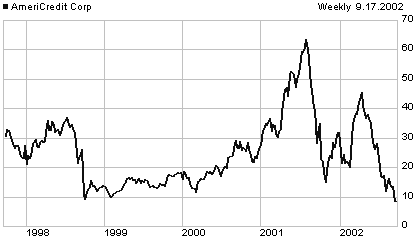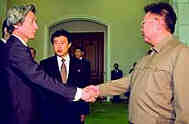1939 Treacherous Soviet Union
invades Poland, already agonizing under Nazi onslaught,
during WW II. ^top^
— L'armée rouge envahit la Pologne.
Soviet Foreign Minister Vyacheslav
Molotov declares that the Polish government has ceased to exist,
as the USS.R. exercises the "fine print" of the Hitler-Stalin
Non-aggression pact—the invasion and occupation of eastern Poland.
Hitler's troops were already wreaking havoc in Poland, having
invaded on the first of the month. The Polish army began retreating
and regrouping east, near Lvov, in eastern Galicia, attempting
to escape relentless German land and air offensives.
But Polish troops had jumped
from the frying pan into the fire—as Soviet troops began occupying
eastern Poland. The Ribbentrop-Molotov Non-aggression Pact,
signed in August, had eliminated any hope Poland had of a Russian
ally in a war against Germany. Little did Poles know that a
secret clause of that pact, the details of which would not become
public until 1990, gave the USS.R. the right to mark off for
itself a chunk of Poland's eastern region. The "reason" given
was that Russia had to come to the aid of its "blood brothers,"
the Ukrainians and Byelorussians, who were trapped in territory
that had been illegally annexed by Poland. Now Poland was squeezed
from West and East—trapped between two behemoths. Its forces
overwhelmed by the mechanized modern German army, Poland had
nothing left with which to fight the Soviets.
As Soviet troops broke into Poland,
they unexpectedly met up with German troops who had fought their
way that far east in a little more than two weeks. The Germans
receded when confronted by the Soviets, handing over their Polish
prisoners of war. 217'000 Polish soldiers were taken into captivity;
some Poles simply surrendered to the Soviets to avoid being
captured by the Germans. The Soviet Union would wind up with
about three-fifths of Poland and 13 million of its people as
a result of the invasion. |
1934 1st 33 1/3 rpm recording released (Beethoven's 5th)
1934 La URSS ingresa en la Sociedad de Naciones.
1930 Work begins on Boulder
(later Hoover) Dam ^top^
Construction of Hoover Dam, originally
called Boulder Dam, began at Black Canyon, near Las Vegas, Nevada.
Built during the Depression, thousands of men and their families
came to Black Canyon to tame the mighty Colorado River, working
under dangerous conditions in a harsh environment. Completed
in less than five years, the largest dam of its era was a world-renowned
engineering feat, and an endlessly renewable source of power
for the growing Southwest. |
1923 Disolución de las Cortes en España. Se constituye el Directorio
Militar, en sustitución del provisional formado tras el golpe de Estado
del general Primo de Rivera.
1922 highest air temperature ever observed on Earth:
58ºC at Azizia, near Tripoli, Libya.
1922 Radio Moscow begins transmitting (12 KWs-most powerful
station)
1917 The German Army recaptures the Russian Port of Riga from
Russian forces.
1911 1st transcontinental airplane flight, NY-Pasadena in 82
hrs 4 min
1903 International coast-to-coast drive.
Lester L. Whitman and Eugene I. Hammond complete their coast-to-coast
drive, the third trans-US automobile trip in history, with a section
from Windsor to Niagara Falls in Ontario, Canada, in order to make the
trip "international.”
1902 US troops are sent to Panama to keep train lines open over
the isthmus as Panamanian nationals struggle for independence from Colombia.
1873 19 students attend opening class at Ohio State University
1864 John C. Frémont withdraws as third-party candidate
for US President
1863 Pope Pius IX encyclical On persecution in New Grenada
1862 Union forces evacuate Cumberland Gap, Tennessee/Kentucky
1862 Munfordville, Kentucky surrenders
1861 Siege of Lexington, Missouri continues
1854 Publicación del Manifiesto de la Unión Liberal, fundada por
Leopoldo O'Donnell, como escisión del Partido Moderado.
1820 John Keats leaves for Italy
^top^
With less than six months to
live, 24-year-old John Keats sets off for Italy on this day
in 1820, hoping the climate will improve his tuberculosis.
Keats had produced an outpouring
of brilliant poetry in 1819, including classics like "Ode on
a Grecian Urn," "Ode to a Nightingale," and "La Belle Dame Sans
Merci.” His productivity and talent are still astonishing today
considering that he came from a lower-class family, lacked the
educational and financial advantages of other writers of his
age, and did not try his hand at poetry until he turned 18.
Keats’ parents ran a London stable,
earning enough to send John, the eldest of five children, to
private school. Keats was boisterous and high-spirited, but
his schoolmasters discovered a keen interest in reading and
introduced him to poetry and theater. When John was eight, his
father died, launching a long economic struggle that would keep
Keats in poverty throughout his life, despite a large inheritance
that was owed him. Eventually, Keats’ unscrupulous guardian,
who kept the money from him, apprenticed Keats to a surgeon.
Keats worked with the surgeon from 1811 until 1814, then went
to work for a hospital in London as a junior apothecary and
surgeon in charge of dressing wounds.
In London, Keats pursued his
interest in literature while working at the hospital. He became
friends with the editor of the Examiner, Leigh Hunt, a successful
poet and author who introduced him to other literary figures,
including Percy Bysshe Shelley. Although Keats did not write
his first poem until age 18, he quickly showed tremendous promise,
encouraged by Hunt and his circle. Keats’ work first appeared
in the Examiner in 1816, followed by his first book, Poems (1817).
After 1817, Keats devoted himself entirely to poetry, becoming
a master of the Romantic sonnet and trying his hand at epic
poems like Hyperion.
In 1818, Keats’ financial struggles
deepened when his brother Tom fell ill with tuberculosis and
another brother’s poor investments left him penniless. Meanwhile,
a strenuous walking tour of England’s Lake District damaged
Keats’ health. The one bright spot in his life was Fanny Brawne,
his fiancee. Sadly, Keats’ poverty did not allow them to marry.
He developed tuberculosis in 1820, traveled to Italy hoping
to improve his condition, and died there in February 1821
KEATS ONLINE:
The
Eve of St. Agnes, Lamia,
The Poetical
Works of John Keats. |
1809 Treaty of Fredrikshamm ends the Russo-Swedish war, ceding Finland
to Russia.
1808 Napoléon confie à Fontanes la direction de l'université impériale.
Il la veut laïque et il lui confère le monopole de l'enseignement. Néanmoins,
Fontanes laisse se créer des institutions privées et introduit dans l'université
même un grand nombre de prêtres.
1796 President George Washington delivers his "Farewell Address"
to Congress before concluding his second term in office. When George
Washington announced that he would retire from office he set the stage
for the nation's first two party presidential campaign.
1793 Revolución francesa: el Comité de Salvación Pública inicia
la represión sanguinaria conocida como "el Terror".
1789 William Herschel discovers Mimas, satellite of Saturn
1787 The Constitution of the United States was completed and
signed by a majority of delegates attending the constitutional convention
in Philadelphia.
1776 Along the western coast of North America,
a party of 247 Spanish colonists consecrate their newly-founded mission,
known as San Francisco.
1717 The first synod of the Presbyterian Church in America met
in Philadelphia.
1656 Massachusetts enacts severe laws against Quakers. (At the
time, government and religion were intricately interwoven; the line between
blasphemy and treason was virtually nonexistent; and non-sacramental
Quakerism gave the impression that the denomination was anti-government.) |
 On
a 17 September:
On
a 17 September:  During talks in Pyongyang with Japan's Prime Minister Junichiro Koizumi,
aimed at normalizing relations, North Korean dictator Kim Jong Il, desperate
to get economic aid from Japan, confesses that North Korean secret services
have abducted 11 Japanese in past years (number later increased to 13),
supposedly so as to have them as Japanese language instructors and/or
to assume their identities. Kim states that those responsible have been
punished, and that such abductions will never happen again.
During talks in Pyongyang with Japan's Prime Minister Junichiro Koizumi,
aimed at normalizing relations, North Korean dictator Kim Jong Il, desperate
to get economic aid from Japan, confesses that North Korean secret services
have abducted 11 Japanese in past years (number later increased to 13),
supposedly so as to have them as Japanese language instructors and/or
to assume their identities. Kim states that those responsible have been
punished, and that such abductions will never happen again. 